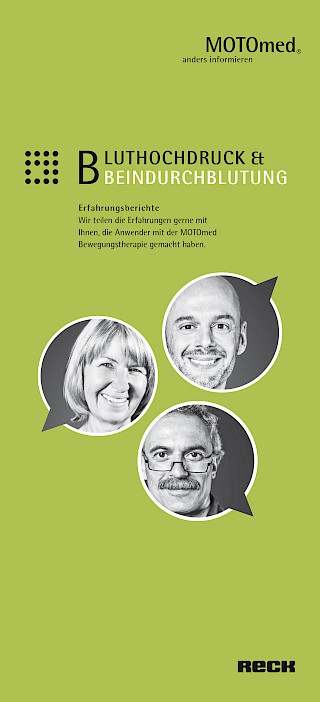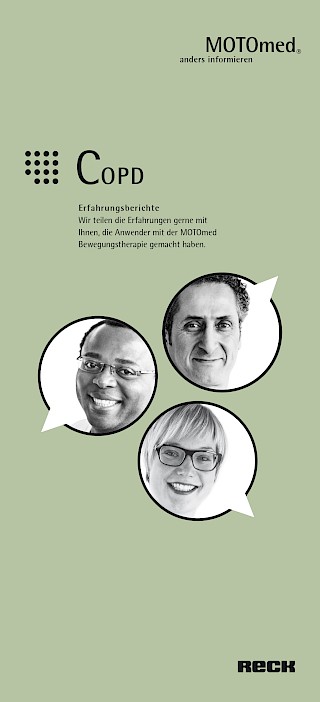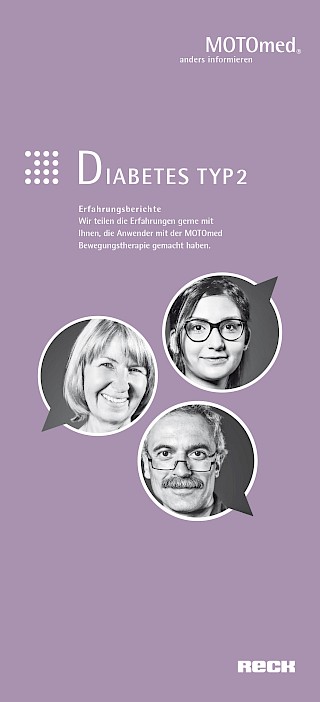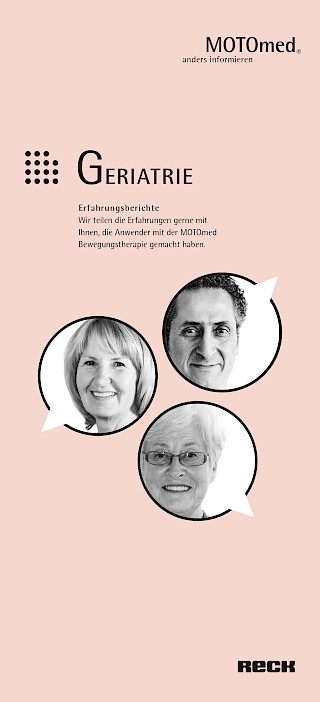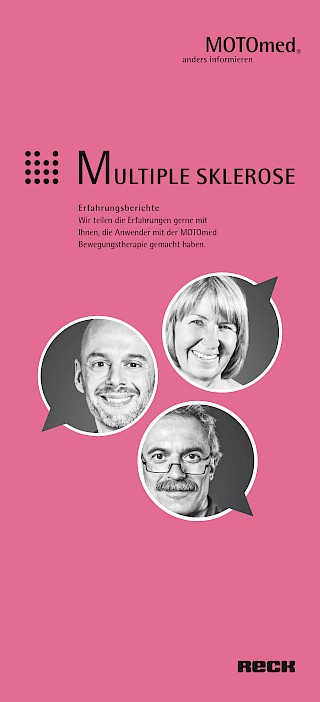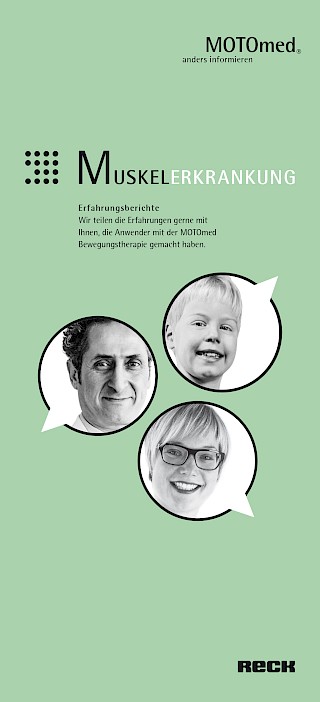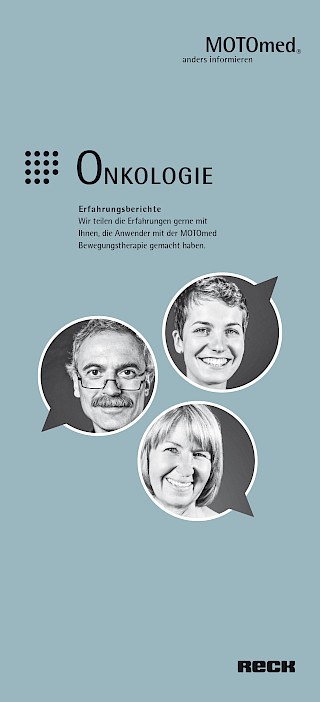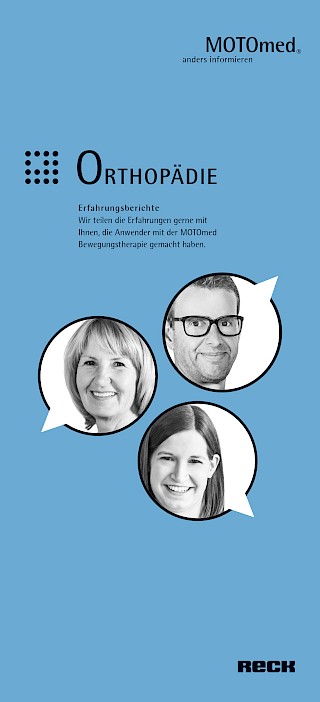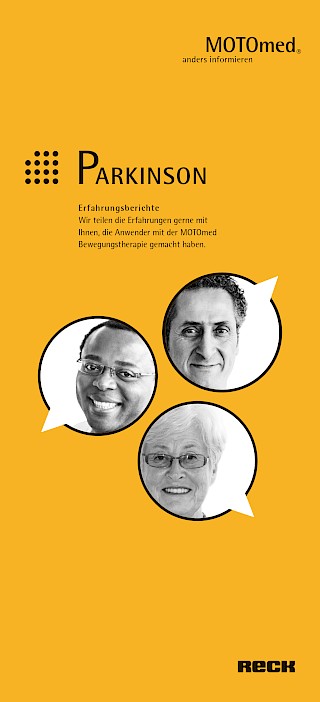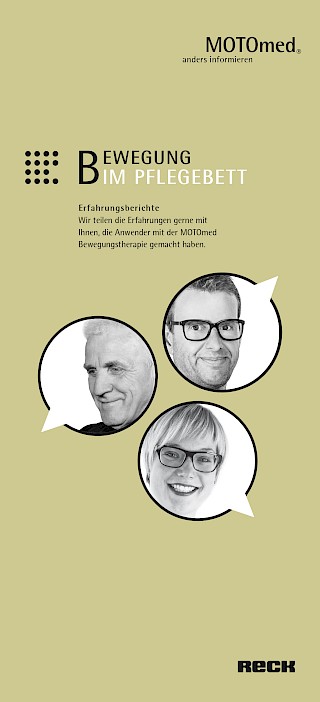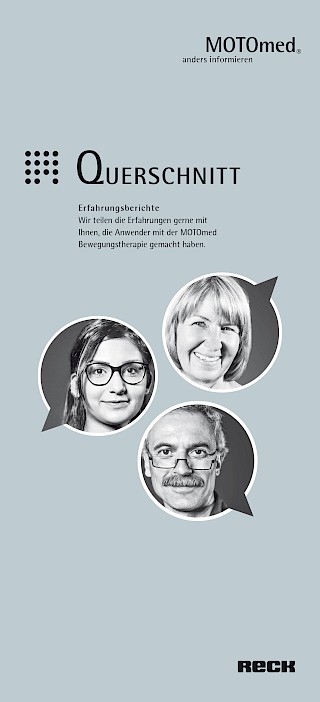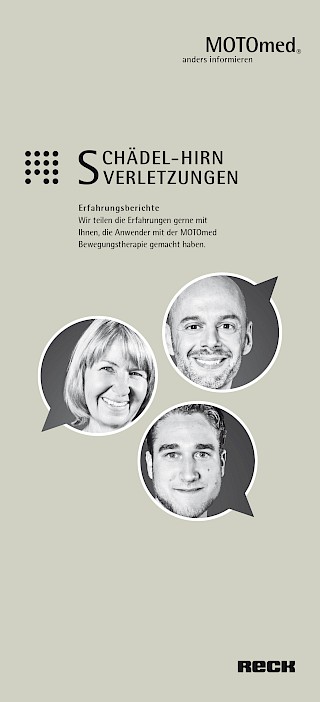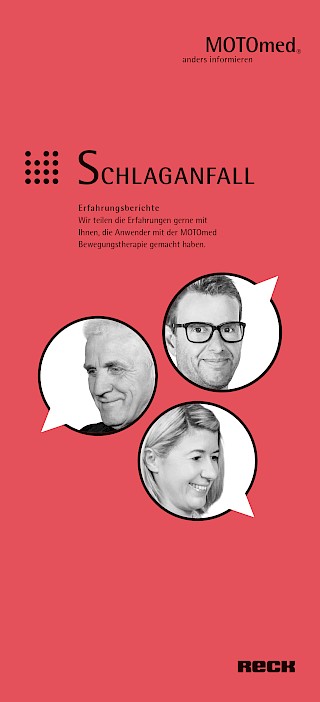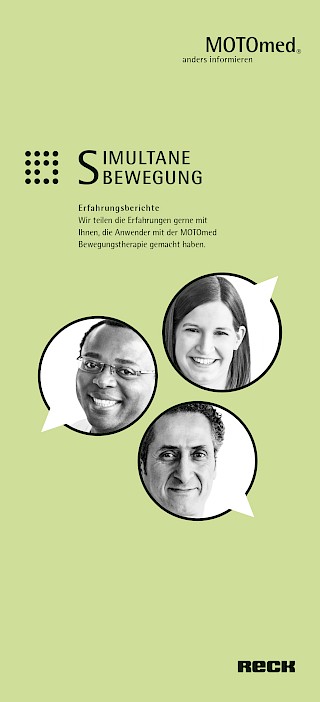Information-Center
Wissenschaftliche Studien und Forschungsergebnisse zur MOTOmed Bewegungstherapie in der Schlaganfall-Rehabilitation
1.18) Hu Y., Tian J., Wen X., Lu C., Tian N. (2022). Clinical Effects of MOTOmed Intelligent Exercise Combined with Intensive Walking Training on the Rehabilitation of Walking, Nerve and Lower Limb Functions among Patients with Hemiplegia after Stroke, DOI: 10.12669/PJMS.38.5.5259
1.17) Minh D.N., Thanh V.T., Quoc V.N., Ninh K.N., Son T.V., Luu T.N., Linh V.P.D. (2023). Effectiveness on post-stroke hemiplegia in patients: electroacupuncture plus cycling vs electroacupuncture alone, DOI: 10.19852/J.CNKI.JTCM.2023.02.006
1.16) Simić Panić D., Spasojević T., Pantelinac S., Živanović Ž., Vojinović L., Tomašević T. (2024). The impact of cycling exercise on motor and functional recovery of patients in acute and subacute stroke phase, DOI: 10.2298/SARH231025032S
1.15) Kotov S.V., Isakova E.V., Sheregeshev V.I. (2020). Possibilities for Correcting Emotional and Behavioral Impairments in Stroke Patients during Rehabilitation Therapy. Neuroscience and Behavioral Physiology, 50, 156-161., DOI: 10.1007/s11055-019-00882-1
1.14) Shen C., Liu F., Yao L., Li Z., Qiu L., Fang S. (2018). Effects of MOTOmed movement therapy on the mobility and activities of daily living of stroke patients with hemiplegia: a systematic review and meta-analysis. Clinical rehabilitation, 32(12), 1569-1580., DOI: 10.1177/0269215518790782
1.13) Yang H.-C., Lee C.-L., Lin R., Hsu M.-J., Chen C.-H., Lin J.-H., Lo S.K. (2014). Effect of biofeedback cycling training on functional recovery and walking ability of lower extremity in patients with stroke. The Kaohsiung Journal of Medical Sciences, 30(1), 35-42., DOI: 10.1016/j.kjms.2013.07.006
1.12) Ambrosini E., Ferrante S., Pedrocchi A., Ferrigno G., Molteni F. (2011). Cycling Induced by Electrical Stimulation Improves Motor Recovery in Postacute Hemiparetic Patients: A Randomized Controlled Trial. Stroke, 42(4), 1068-1073., DOI: 10.1161/STROKEAHA.110.599068
1.11) Podubecka J., Scheer S., Theilig S., Wiederer R., Oberhoffer R., Nowak D.A. (2011). Zyklisches apparatives Bewegungstraining versus konventionelles Gangtraining in der Rehabilitation des hemiparetischen Ganges nach Schlaganfall: Eine Pilotstudie. Fortschritte der Neurologie Psychiatrie, 79(7), 411-418., DOI: 10.1055/s-0031-1273338
1.10) Skvortsova V.I., Ivanova G.E., Rumyantseva N.A., Staritsyn A.N., Kovrazhkina E.A., Suvorov A.Yu. (2011). Current Approaches to Restoring Walking in Patients during the Acute Phase of Cerebral Stroke. Neuroscience and Behavioral Physiology, 41(5), 536-541., DOI: 10.1007/s11055-011-9451-4
1.8) Dobke B., Schüle K., Diehl W., Kaiser T. (2010). Apparativ-assistive Bewegungstherapie in der Schlaganfallrehabilitation. Neurologie & Rehabilitation, 16(4), 173-185.
1.7) Eigler F. (2009). Funktionelle Elektrostimulation am Beinergometer in der Rehabilitation nach Schlaganfall: Der Einsatz funktioneller Elektrostimulation während des Trainings am zyklischen Beinbewegungstrainer (FES-LCE) in der stationären Rehabilitation nach zerebralem ischämischem Infarkt. Dissertation, Universität Heidelberg, Institut für Sport und Sportwissenschaft., DOI: 10.11588/heidok.00009950
1.6) Wan X., Gao C., Ye Z., Huang Z., Pan C. (2009). Einfluss des MOTOmed Beintrainings auf halbseitig gelähmte Schlaganfallpatienten. Chinese Journal of Physical Medicine and Rehabilitation, 31(7), 503-504.
1.5) Lennon O., Carey A., Gaffney N., Stephenson J., Blake C. (2008). A pilot randomized controlled trial to evaluate the benefit of the cardiac rehabilitation paradigm for the non-acute ischaemic stroke population. Clinical Rehabilitation, 22(2), 125-133., DOI: 10.1177/0269215507081580
1.4) Diserens K., Perret N., Chatelain S., Bashir S., Ruegg D., Vuadens P., Vingerhoets F. (2007). The effect of repetitive arm cycling on post stroke spasticity and motor control: Repetitive arm cycling and spasticity. Journal of the Neurological Sciences, 253 (1-2), 18-24., DOI: 10.1016/j.jns.2006.10.021
1.3) Bashir S. (2006). Rehabilitation of stroke and cerebellar patients. Thesis, Institute of Physiology, University of Fribourg.
1.2) Kamps A., Schüle K. (2005). Zyklisches Bewegungstraining der unteren Extremitäten in der Schlaganfallrehabilitation. Neurologie & Rehabilitation, 11(5), 259-269.
1.1) Demmer P.C. (2005). Überprüfung der Ausdauerfähigkeit von Schlaganfallbetroffenen durch ein apparativ-assistives Training. Diplomarbeit, Deutsche Sporthochschule Köln.
Wissenschaftliche Studien und Forschungsergebnisse zur MOTOmed Bewegungstherapie in der Geriatrie
2.2) Carballeira E., Censi K.C., Maseda A., López-López, R., Millán-Calenti J.C. (2021). Low-volume cycling training improves body composition and functionality in older people with multimorbidity: a randomized controlled trial. Scientific Reports, 11(1), 13364., DOI: 10.1038/s41598-021-92716-9
2.1) Diehl W., Schüle K., Kaiser T. (2008). Apparativ-assistives Bewegungstraining der unteren Extremitäten in der geriatrischen Rehabilitation. NeuroGeriatrie, 5(1), 3-12.
Wissenschaftliche Studien und Forschungsergebnisse zur MOTOmed Bewegungstherapie bei Multipler Sklerose
3.3) Máté S., Corr N., Hackett D., Barnett M., Singh M.F., Fornusek C. (2024). Functional electrical stimulation combined with voluntary cycling accentuates VO2 response in people with severe multiple sclerosis: A pilot study, DOI: 10.1016/J.MSARD.2024.105552
3.2) Hochsprung A., Granja Dominguez A., Magni E., Escudero Uribe S., Moreno Garcia A. (2017). Effect of visual biofeedback cycling training on gait in patients with multiple sclerosis. Neurologia, 35(2), 89-95., DOI: 10.1016/j.nrl.2017.07.008
3.1) Rösche J., Paulus C., Maisch U., Kaspar A., Mauch E., Kornhuber H.H. (1997). The effects of therapy on spasticity utilizing a motorized exercise-cycle. Spinal Cord, 35, 176-178., DOI: 10.1038/sj.sc.3100376
Wissenschaftliche Studien und Forschungsergebnisse zur MOTOmed Bewegungstherapie (Forced Exercise) bei Parkinson
4.11) Pereira-Pedro K.P., Machado de Oliveira I., Mollinedo-Cardalda I., Cancela-Carral J.M. (2022). Effects of cycling dual-task on cognitive and physical function in Parkinson´s disease: a randomized double-blind pilot study, DOI: 10.3390/IJERPH19137847
4.10) Pereira-Pedro K.K., Machado de Oliveira I., Cancela Carral J.M., Mollinedo Cardalda I. (2023). Effects of MOTOmed® movement therapy on the motor function and main symptoms of patients with Parkinson’s disease: a systematic review. Retos: nuevas tendencias en educación física, deporte y recreación, 47, 249-257., DOI: 10.47197/retos.v47.93936
4.9) Ridgel A., Phillips R. S., Walter B. L., Discenzo F. M., Loparo K. A. (2015). Dynamic high-cadence cycling improves motor symptoms in Parkinson’s disease. Frontiers in Neurology, 6, 194., DOI: 10.3389/fneur.2015.00194
4.8) Stuckenschneider T., Helmich I., Raabe-Oetker A., Froböse I., Feodoroff B. (2015). Active assistive forced exercise provides long-term improvement to gait velocity and stride length in patients bilaterally affected by Parkinson‘s disease. Gait & Posture, 42(4), 485-490., DOI: 10.1016/j.gaitpost.2015.08.001
4.7) Corbett D.B., Peer K.S., Ridgel A.L.(2013). Biomechanical muscle stimulation and active-assisted cycling improves active range of motion in individuals with Parkinson‘s disease. NeuroRehabilitation, 33(2), 313-322, DOI: 10.3233/NRE-130961
4.6) Ridgel A.L., Peacock C.A., Fickes E.J., Kim C.-H. (2012). Active-Assisted Cycling Improves Tremor and Bradykinesia in Parkinson’s Disease. Archives of Physical Medicine and Rehabilitation, 93 (11), 2049-2054., DOI: 10.1016/j.apmr.2012.05.015
4.5) Fickes E.J. (2012). Effects of interval active-assisted cycling on balance in individuals with Parkinson’s disease. Dissertation, Kent State University.
4.4) Ridgel A.L., Kim C.-H., Fickes E.J., Muller M.D., Alberts J.L. (2011). Changes in Executive Function After Acute Bouts of Passive Cycling in Parkinson‘s Disease. Journal of Aging and Physical Activity, 19(2), 87-98., DOI: 10.1123/japa.19.2.87
4.3) Laupheimer M., Härtel S., Schmidt S., Bös K. (2011). Forced Exercise – Auswirkungen eines MOTOmed-Trainings auf parkinson typische motorische Dysfunktionen. Neurologie & Rehabilitation, 17(5/6), 239-246.
4.2) Ridgel A.L., Peacock C.A., Fickes E.J., Kim C.-H.(2010). Effects of active-assisted cycling on upper extremity motor and executive function in Parkinson’s disease. Presentation at the Society of Neuroscience Meeting 2010.
4.1) Ridgel A.L., Vitek J.L., Alberts J.L. (2009). Forced, Not Voluntary, Exercise Improves Motor Function in Parkinson’s Disease Patients. Neurorehabilitation and Neural Repair, 23(6), 600-608., DOI: 10.1177/1545968308328726
Wissenschaftliche Studien und Forschungsergebnisse zur MOTOmed Bewegungstherapie bei Personen mit Bluthochdruck
5.1) Westhoff T.H., Schmidt S., Gross V., Joppke M., Zidek W., van der Giet M., Dimeo F. (2008). The cardiovascular effects of upper-limb aerobic exercise in hypertensive patients. Journal of Hypertension, 26(7), 1336-1342., DOI: 10.1097/HJH.0b013e3282ffac13
Wissenschaftliche Studien und Forschungsergebnisse zur MOTOmed Bewegungstherapie bei Kindern mit neurologischen Erkrankungen
6.5) Damiano D.L., Stanley C.J., Alter K.E., Ohlrich L. (2017). Task-Specific and Functional Effects of Speed-Focused Elliptical or Motor-Assisted Cycle Training in Children With Bilateral Cerebral Palsy: Randomized Clinical Trial, DOI: 10.1177/1545968317718631
6.4) Holmes C., Shields N., Morgan P., Brock K., McKenzie G., Reddihough D. (2024). Home-based motorised cycling in Non-ambulant adults with cerebral palsy: a feasibility study, DOI: 10.1080/09638288.2024.2353234
6.3) Belogorova T., Vlasenko A., Mikhnovich V., Dutova N., Taskaeva T., Bugun O., Rychkova L. (2019). Rehabilitation of children with spastic and dyskinetic forms of cerebral palsy through transcranial exposure and biologically feedback. Archives of Disease in Childhood, 104(Suppl 3), A352., DOI: 10.1136/archdischild-2019-epa.833
6.2) Nurmatova S., Khamraev F., Mirzaev A., Diehl, W. (2012). Effectiveness of motor-assisted MOTOmed movement therapy in the rehabilitation of children diagnosed with infantile cerebral parese. Nevrologiya, 1(53), 34-37.
6.1) Shen M., Li Z.P., Cui Y., Kang L.H., Xie Z.Z., Yao X.H., Gu Q.Y. (2009). Effects of Motomed gracile leg training on the lower limbs function in children with spastic cerebral palsy. Chinese Journal of Rehabilitation Theory and Practice, 9, 828-829.
Wissenschaftliche Studien und Forschungsergebnisse zur MOTOmed Bewegungstherapie während der Hämodialyse
7.6) Anding-Rost K., von Gersdorff G., von Korn P., Ihorst G., Josef A., Kaufmann M., Huber M., Bär T., Zeißler S., Höfling S., Breuer C., Gärtner N., Haykowsky M.J., Degenhardt S., Wanner C., Halle M. (2023). Exercise during Hemodialysis in Patients with Chronic Kidney Failure. NEJM Evidence, EVIDoa2300057., DOI: 10.1056/EVIDoa2300057
7.5) Mitsiou M., Dimitros E., Roumeliotis S., Liakopoulos V., Kouidi E., Deligiannis A. (2022). Effects of a Combined Intradialytic Exercise Training Program and Music on Cardiac Autonomic Nervous System Activity in Hemodialysis Patients. Life, 12(8), 1276., DOI: 10.3390/life12081276
7.4) Dziubek W., Bulińska K., Rogowski Ƚ., Kusztal M., Zembroń-Ƚacny A., Goƚȩbiowski T., Markowska D., Klinger M., Woźniewski M. (2016). Three-month endurance training improves functional fitness and knee muscle performance of patients with end stage renal disease (ESRD). Isokinetics and Exercise Science, 24(3), 237-246., DOI: 10.3233/IES-160623
7.3) Dziubek W., Kowalska J., Kusztal M., Rogowski Ƚ., Gołębiowski T., Nikifur M., Szczepańska-Gieracha J., Zembroń- Łacny A., Klinger M., Woźniewski M. (2016). The Level of Anxiety and Depression in Dialysis Patients Undertaking Regular Physical Exercise Training – a Preliminary Study. Kidney Blood Pressure Research, 41(1), 86–98., DOI: 10.1159/000368548
7.2) Anding K., Bär T., Trojniak-Hennig J., Kuchinke S., Krause R., Rost J.M., Halle M. (2015). A structured exercise program during haemodialysis for patients with chronic kidney disease: clinical benefit and long-term adherence. BMJ Open, 5(8)., DOI: 10.1136/bmjopen-2015-008709
7.1) Torkington M., MacRae M., Isles C. (2006). Uptake of and adherence to exercise during hospital haemodialysis. Physiotherapie, 92(2), 83-87., DOI: 10.1016/j.physio.2005.08.004
Wissenschaftliche Studien und Forschungsergebnisse zur MOTOmed Bewegungstherapie bei bettlägerigen oder komatösen Personen
8.10) Hickmann C.E., Montecinos-Munoz N.R., Castanares-Zapatero D., Arriagada-Garrido R.S., Jeria-Blanco U., Gizzatullin T., Roeseler J., Dugernier J., Wittebole X., Laterre P.-F. (2021). Acute effects of sitting out of bed and exercise on lung aeration and oxygenation in critically ill subjects. Respiratory care, 66(2), 253-262., DOI: 10.4187/respcare.07487
8.9) Nickels M.R., Aitken L.M., Barnett A.G., Walsham J., McPhail S.M.Publish (2020). Acceptability, safety, and feasibility of in-bed cycling with critically ill patients. Australian Critical Care, 33(3), 236-243., DOI: 10.1016/j.aucc.2020.02.007
8.8) Yu L., Jiang J.-X., Zhang Y., Chen Y.-Z., Shi Y. (2020). Use of in-bed cycling combined with passive joint activity in acute respiratory failure patients receiving mechanical ventilation. Annals of Palliative Medicine, 9 (2), 175-181., DOI: 10.21037/apm.2020.02.12
8.7) Sommers J., Klooster E., Zoethout S.B., van den Oever H.L.A., Nollet F., Tepaske R., Horn J., Engelbert R.H.H., van der Schaaf M. (2019). Feasibility of Exercise Testing in Patients Who Are Critically Ill: A Prospective, Observational Multicenter Study. Archives of physical medicine and rehabilitation, 100(2), 239-246, DOI: 10.1016/j.apmr.2018.07.430
8.6) De Beer C., Van Rooijen A., Pretorius J., Becker P., Rheeder P., Paruk F. (2018). Muscle strength and endurance to predict successful extubation in mechanically ventilated patients: A pilot study evaluating the utility of upper-limb muscle strength and ergometry. Southern African Journal of Critical Care, 34(2), 44-51., DOI: 10.7196/SAJCC.2018.v34i2.360
8.5) Hickmann C., Castanares-Zapatero D., Deldicque L., Van den Bergh P., Caty G., Robert A., Roesler J., Francaux M., Laterre P.-F. (2018). Impact of Very Early Therapy During Septic Shock on Skeletal Muscle: A Randomized Controlled Trial. Critical Care Medicine., DOI: 10.1097/CCM.0000000000003263
8.4) Dos Santos Machado A., Pires-Neto R.C., Ximenes Carvalho M.T., Soares J.C., Cardoso D.M., Martins de Albuquerque I. (2017). Effects that passive cycling exercise have on muscle strength, duration of mechanical ventilation, and length of hospital stay in critically ill patients: a randomized clinical trial. Jornal brasileiro de pneumologia, 43(02), 134-139., DOI: 10.1590/S1806-37562016000000170
8.3) Schaller S., Anstey M., Blobner M., Edrich T., Grabitz S., Gradwohl-Matis I., Heim M., Houle T., Kurth T., Latronico N., Lee J., Meyer M., Peponis T., Talmor D., Velmahos G., Waak K., Walz J., Zafonte R., Eikermann M. (2016). Early, goal-directed mobilization in the surgical intensive care unit: a randomised controlled trial. The Lancet, 388 (10052), 1377-88., DOI: 10.1016/S0140-6736(16)31637-3
8.2) Kho M. E., Martin R. A., Toonstra A. L., Zanni J.M., Mantheiy E.C., Nelliot A., Needham D.M. (2015). Feasibility and safety of in-bed cycling for physical rehabilitation in the intensive care unit (ICU). Journal of Critical Care, 30(6), 1419., DOI: 10.1016/j.jcrc.2015.07.025
8.1) Burtin C., Clerckx B., Robbeets C., Ferdinande P., Langer D., Troosters T., Hermans G., Decramer M., Gosselink R. (2009). Early exercise in critically ill patients enhances short-term functional recovery. Critical Care Medicine, 37(9), 2499-2505., DOI: 10.1097/CCM.0b013e3181a38937
Wissenschaftliche Studien und Forschungsergebnisse zur MOTOmed Bewegungstherapie bei bettlägerigen Personen mit COPD
9.3) Prieur G., Combret Y., Bonnevie T., Gravier F.E., Quesada A.R., Quiffin J., Lamia B., Medrinal C. (2019). Functional Electrical Stimulation Changes Muscle Oxygenation in Patients with Chronic Obstructive Pulmonary Disease During Moderate-Intensity Exercise: A Secondary Analysis, DOI: 10.1080/15412555.2018.1560402
9.2) Zong M., Shen H., Ren L., Han T., Chen Y., Lu J., Zhang Y., Li S., Sun J. (2023). Effects of whey protein complex combined with lowintensity exercise in elderly inpatients with COPD at a stable stage, DOI: 10.6133/APJCN.202312_32(4).0001
9.1) Galetke W., Randerath W., Pfeiffer M., Feldmeyer F., Rühle K.-H. (2002). Spiroergometrie bei bettlägerigen Patienten mit schwergradiger COB. Pneumologie, 56(2), 98-102., DOI: 10.1055/s-2002-20087
Wissenschaftliche Studien und Forschungsergebnisse zur MOTOmed Bewegungstherapie bei demenziellen Erkrankungen
10.1) Holthoff V.A., Marschner K., Scharf M., Steding J., Meyer S., Koch R., Donix M. (2015). Effects of Physical Activity Training in Patients with Alzheimer‘s Dementia: Results of a Pilot RCT Study. PLOS ONE, 10(4)., DOI: 10.1371/journal.pone.0121478
Wissenschaftliche Studien und Forschungsergebnisse zur MOTOmed Bewegungstherapie bei an Krebs Erkrankten
11.1) Schmidt T., Berner J., Jonat W., Weisser B., Röcken C., van Mackelenbergh M., Mundhenke C. (2017). Influence of arm crank ergometry on development of lymphedema in breast cancer patients after axillary dissection: a randomized controlled trail. Journal of Rehabilitation Medicine, 49(1), 78-83., DOI: 10.2340/16501977-2167
Wissenschaftliche Studien und Forschungsergebnisse zur MOTOmed Bewegungstherapie bei Querschnittslähmung
12.2) Kuhn D., Leichtfried V., Schobersberger W., Röhl K. (2013). FES-Cycling bei Menschen mit Querschnittlähmung – Auswirkungen auf subjektives Empfinden und Aktivitäten des täglichen Lebens. Physioscience, 9(4), 142-150., DOI: 10.1055/s-0033-1355939
12.1) Muraki S., Ehara Y., Yamasaki M. (2000). Cardiovascular responses at the onset of passive leg cycle exercise in paraplegics with spinal cord injury. European Journal of Applied Physiology, 81(4), 271-274., DOI: 10.1007/s004210050042
Wissenschaftliche Studien und Forschungsergebnisse zur MOTOmed Bewegungstherapie bei orthopädischen Erkrankungen
Kim H. J., Kwon J. Y., Kim J.S. Kim M. W., Bang H. J., Lee W. I., Ko Y. J. (2006). Preferential Vastus Medialis Oblique Activation Achieved by Isokinetic Cycling at High Angular Velocity. Journal of the Korean Academy of Rehabilitation Medicine, 30(5), 481-484.


